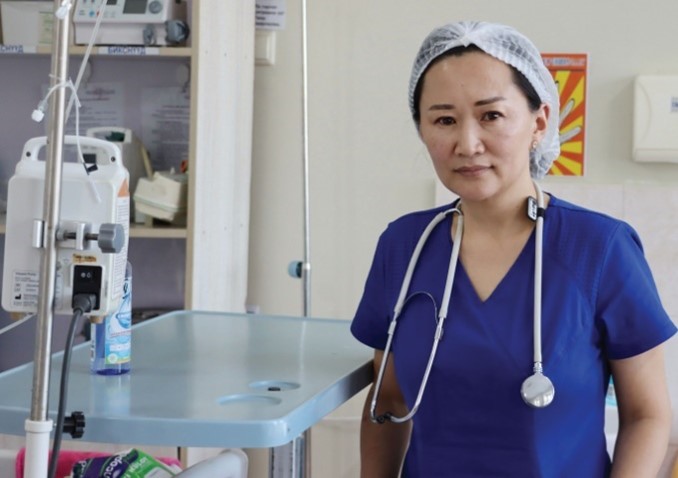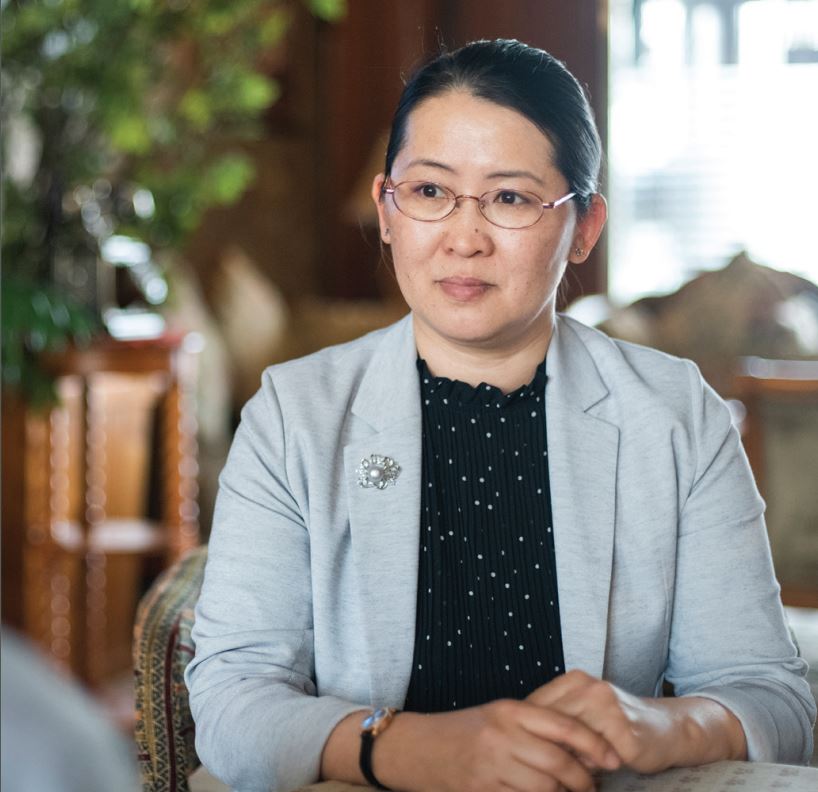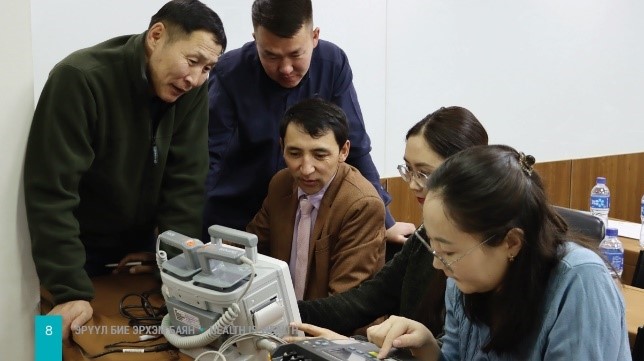Batpurev Chuluun, Communications Consultant, Save the Children Japan in Mongolia
The Meeting Targets and Maintaining Epidemic Control (EpiC) project, implemented by FHI 360 in partnership with Save the Children in Mongolia since February 2022, trained hospital and soum-level (or rural primary) doctors and specialists, along with medical equipment engineers, on the use of ventilators, maintaining oxygen ecosystems, oxygen therapy, and critical care for patients with COVID-19. Read on to hear perspectives from members of the health workforce on the impact of the project in Mongolia.

Dr. Nansalmaa Dorjgotov has served in her role for five years. Her department has two doctors, an anesthesiologist, four intensive care nurses, and four auxiliary nurses. The department has a bed capacity of four adults, two children, and two infants, and has 20 ventilators and an ambulance equipped with a mobile respirator. Here, Dr. Dorjgotov shares her perspective after attending the training Clinical Management and Oxygen Therapy for COVID-19 Cases at Primary Level Health Care Settings, held by the EpiC project.
The pressure on our ICU had increased from wave to wave during the COVID-19 pandemic. We had to refill our oxygen balloons from Ulaanbataar (45 kilometers away) and transport them to our soum. The MOH installed a medical oxygen plant, which allowed us to provide medical oxygen directly from a wall socket to our ICU as well as other departments of our hospital.
I am now certified to facilitate trainings on the topic of Clinical Management and Oxygen Therapy for COVID-19 cases at Primary Level Health Care Settings after attending a training organized by EpiC Mongolia. The benefit I got from the training was not limited to new professional skills; it also sparked ideas and insights that I can use in my work. Another important thing that I appreciated was that the participants were provided with handbooks used in international practice. Operational guidelines and instructions were developed as an integral part of our hospital’s internal bylaw. I developed the regulation for our hospital together with my colleagues, and the operating procedure for a mechanical ventilator is attached to this internal bylaw. I will provide further training to other soum doctors on the proper use of oxygen cylinders, as they lack the skills and knowledge for oxygen therapy, patient triage, charging and safely transporting the oxygen cylinder. Doctors serving the soum communities get their advice and instruction from me in the form of telemedicine or face-to-face meetings.

Janserik Aitugan shares his experience attending a workshop held by the EpiC project in December 2022 to build capacity of hospital engineers to operate and maintain medical equipment in Mongolia. The EpiC-supported workshop was co-hosted by Assist International, a medical equipment control and coordination institution.
I graduated from the University of Science and Technology as a medical equipment engineer and have been working for Bayan-Ulgii Aimag Central Hospital for three years. There are two engineers and three technicians in our hospital. There are five of us working as a team, and we are responsible for the operation of all equipment and oxygen production. Although the number of devices per engineer should be 100, our engineers are now responsible for more than 500 devices, as we have a total of 1,500.
This series of EpiC-supported workshops was unique thanks to the quality of the teaching on theory and practice. The consultants from the co-organizer, Assist International, generously shared their experience in terms of inspection, minor damage repair, and configuration setup. The consultants stressed the importance of checking equipment at regular intervals. Similar training or workshops need to be offered to medical equipment technicians, as this equipment is always on the cutting edge of technology and the types of equipment needed frequently change. Therefore, these types of workshops and coaching sessions need to reach as many engineers as possible. I have participated in several trainings, such as general training for engineers and programmers. I also participated in a three-day workshop on refrigeration cycle maintenance since the temperature at which vaccines are required to be stored must be very accurate. I have started to share my new skills and experience with others.

Dr. Navchaa Gombodorj reflects on the Ministry of Health’s partnership with the EpiC project that built the capacity of the health system to handle additional surges of COVID-19 and future epidemics.
The health sector in Mongolia is regularly supplied with essential equipment. Nevertheless, we had a shortage of respiratory support equipment. During a wave of COVID-19, there was an enormous number of patients who had respiratory failure and we realized we couldn’t provide enough oxygen to treat critical care patients. Right at that time, we were provided with essential equipment by the EpiC project, and an oxygen ecosystem was also set up for direct supply to wall outlets in aimag (central) hospitals.
Although the government provided a medical oxygen plant, it was not possible for the government to meet the needs of all hospitals at the same level in such a short period. With the support of the EpiC project, we were able to achieve equitable levels of oxygen supply across many facilities. The project laid the foundation for a sustainable and reliable mechanism in the health sector, contributing safe equipment as well as coaching in maintenance and service. We are now prepared, both in terms of equipment and personnel, for an emergency situation such as COVID-19. Our doctors, nurses, and engineers are well-trained and educated to use, maintain, and repair the equipment, so we will be able to put it to good use into the future.
Including medical equipment engineers in the trainings was critical, as teamwork within facilities is very beneficial. Previously, engineers were trained separately by region. But in this case, the doctors, nurses and engineers from all provinces were able to learn from each other and master the same level of content and competence.
Intensive care doctors from provinces and districts were trained as trainers under the project. Additionally, all nurses and doctors from all soums have been trained in triage and rapid first aid.Developing a pool of national trainers is a real advantage for us. National trainers are key as they know the weaknesses and strengths of their communities and can put into practice and localize the skills learned from the experts.

Dr. Sergelen Jigjidsuren shares her thoughts after completing a capacity building training organized by the EpiC project.
In August 2022, I attended training on Clinical Care Management and Oxygen Therapy in the Primary Health Care System for Cases of COVID-19 Infection in Erdenet city. A total of 32 doctors and nurses from 16 soums in Bulgan Province gathered to improve their knowledge and abilities. During the escalating spread of the COVID-19 pandemic, it was particularly important for intensive care and emergency medical specialists to receive comprehensive training that integrated theory and practice. I thought ‘if only this training had been conducted two years ago.’
Needs-based training, rich in content, was required. For instance, operating an oxygen cylinder needs skill. All hospital personnel must be well informed. We have the advantage of learning independently and becoming trainers in our community, which allows us to instruct other medical professionals. The training was timely and provided an excellent course that will prove useful not only for newly emerging and reemerging infectious diseases, but also in emergencies.

